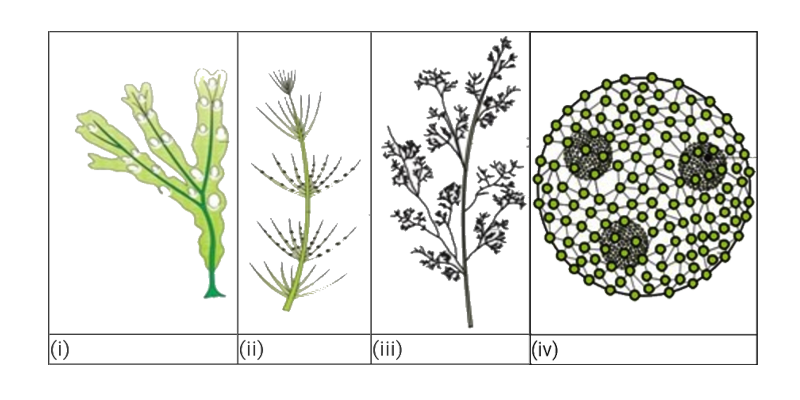Which of these alage exhibit the haplo-diplontic life cycle?
Fucus, Ulothrix
Ectocarpus, Polysiphonia
Volvox, Laminaria
Spirogyra, Lamininaria
To determine which algae exhibit the haplo-diplontic life cycle, we need to understand the characteristics of the different types of life cycles in algae: haplontic, diplontic, and haplodiplontic.
1. Understand Life Cycle Types:
- Haplontic Life Cycle: In this cycle, the dominant stage is the gametophyte, which is haploid (N). The sporophyte stage is short-lived and diploid (2N).
- Diplontic Life Cycle: Here, the dominant stage is the sporophyte, which is diploid (2N). The gametophyte stage is reduced and haploid (N).
- Haplodiplontic Life Cycle: This cycle features both gametophyte and sporophyte stages that are well-developed. Typically, both stages are present in approximately equal proportions.
2. Identify Algae Types:
- Fucus: Exhibits a diplontic life cycle (dominant sporophyte).
- Eulothrix: Exhibits a haplontic life cycle (dominant gametophyte).
- Ectocarpus: Exhibits a haplodiplontic life cycle (both stages present).
- Polysiphonia: Exhibits a haplodiplontic life cycle (both stages present).
- Volvox: Exhibits a haplontic life cycle (dominant gametophyte).
- Laminaria: Exhibits a haplodiplontic life cycle (both stages present).
- Spirogyra: Exhibits a haplontic life cycle (dominant gametophyte).
3. Conclusion:
From the analysis, the algae that exhibit the haplo-diplontic life cycle are Ectocarpus, Polysiphonia, and Laminaria.
Final Answer:
The algae that exhibit the haplo-diplontic life cycle are Ectocarpus, Polysiphonia, and Laminaria.
- Haplontic Life Cycle: In this cycle, the dominant stage is the gametophyte, which is haploid (N). The sporophyte stage is short-lived and diploid (2N).
- Diplontic Life Cycle: Here, the dominant stage is the sporophyte, which is diploid (2N). The gametophyte stage is reduced and haploid (N).
- Haplodiplontic Life Cycle: This cycle features both gametophyte and sporophyte stages that are well-developed. Typically, both stages are present in approximately equal proportions.
- Fucus: Exhibits a diplontic life cycle (dominant sporophyte).
- Eulothrix: Exhibits a haplontic life cycle (dominant gametophyte).
- Ectocarpus: Exhibits a haplodiplontic life cycle (both stages present).
- Polysiphonia: Exhibits a haplodiplontic life cycle (both stages present).
- Volvox: Exhibits a haplontic life cycle (dominant gametophyte).
- Laminaria: Exhibits a haplodiplontic life cycle (both stages present).
- Spirogyra: Exhibits a haplontic life cycle (dominant gametophyte).
From the analysis, the algae that exhibit the haplo-diplontic life cycle are Ectocarpus, Polysiphonia, and Laminaria.
The algae that exhibit the haplo-diplontic life cycle are Ectocarpus, Polysiphonia, and Laminaria.
Topper's Solved these Questions
Similar Questions
Knowledge Check
Haplo-diplontic life cycle is found in
AbryophytesBpteridophytesCfungiDboth a and bComparable to angiospersm, which of the following algae exhibits diplontic life cycle ?
ASpirogyraBEctocarpusCPolysiphoniaDFucusComparable to angioperms to anglosperms, which of the following algae exhibits diplonitic life cycle
ASpirogyraBEctocarpusCPolysiphoniaDFucus
Haplontic Life Cycle
View SolutionWhich algae has diplontic life cycle
View SolutionAn alga which exhibits diplontic life cycle is
View SolutionWhich one of following algae shows haplo-diplontic life cycle ?
View SolutionHow many of these organisms show haplo-diplontic life cycle ?
Sphagnum, Volvox , Ulothrix, Marchantia, Polytrihum, Pinus, Cedrus, Ectocarpus, Polysiphonia
View Solution
